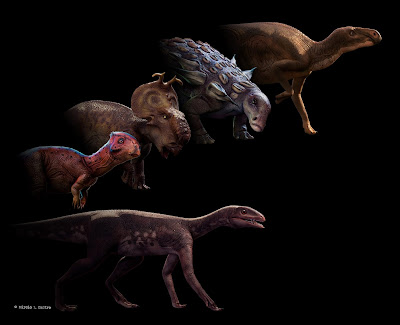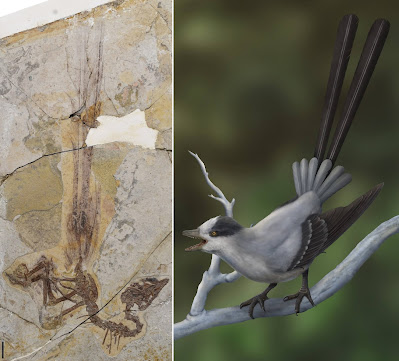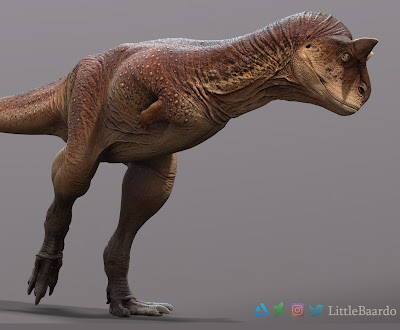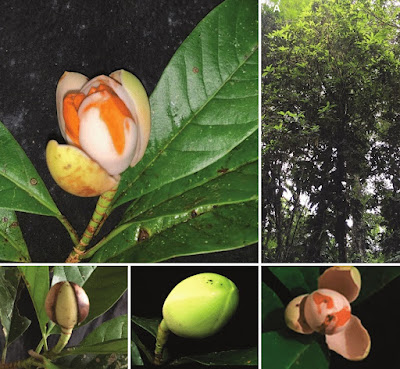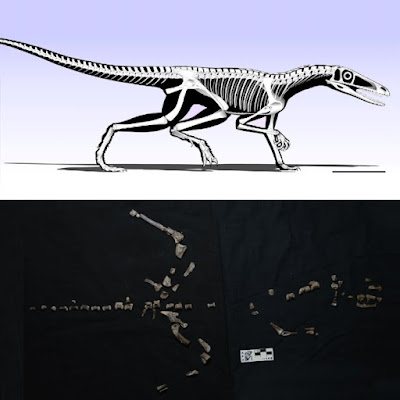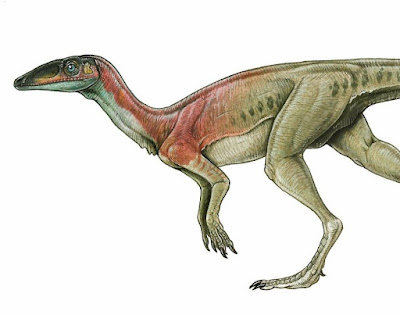[Most Recent Entries] [Calendar View]
Monday, September 20th, 2021
| Time | Event | ||||
| 3:40a | [Paleontology • 2020] A Paraphyletic ‘Silesauridae' as An Alternative Hypothesis for the Initial Radiation of Ornithischian Dinosaurs Abstract Whereas ornithischian dinosaurs are well known from Jurassic and Cretaceous deposits, deciphering the origin and early evolution of the group remains one of the hardest challenges for palaeontologists. So far, there are no unequivocal records of ornithischians from Triassic beds. Here, we present an alternative evolutionary hypothesis that suggests consideration of traditional ‘silesaurids' as a group of low-diversity clades representing a stem group leading to core ornithischians (i.e. unambiguous ornithischians, such as Heterodontosaurus tucki). This is particularly interesting because it fills most of the ghost lineages that emerge from the Triassic. Following the present hypothesis, the lineage that encompasses the Jurassic ornithischians evolved from ‘silesaurids' during the Middle to early Late Triassic, while typical ‘silesaurids' shared the land ecosystems with their relatives until the Late Triassic, when the group completely vanished. Therefore, Ornithischia changes from an obscure to a well-documented clade in the Triassic and is represented by records from Gondwana and Laurasia. Furthermore, according to the present hypothesis, Ornithischia was the first group of dinosaurs to adopt an omnivorous/herbivorous diet. However, this behaviour was achieved as a secondary step instead of an ancestral condition for ornithischians, as the earliest member of the clade is a faunivorous taxon. This pattern was subsequently followed by sauropodomorph dinosaurs. Indeed, the present scenario favours the independent acquisition of an herbivorous diet for ornithischians and sauropodomorphs during the Triassic, whereas the previous hypotheses suggested the independent acquisition for sauropodomorphs, ornithischians, and ‘silesaurids'. Keywords: evolution, Dinosauria, Mesozoic era, phylogenetics, feeding behaviours, Dinosauromorpha Rodrigo Temp Müller and Maurício Silva Garcia. 2020. A Paraphyletic ‘Silesauridae' as An Alternative Hypothesis for the Initial Radiation of Ornithischian Dinosaurs. Biology Letters. 16:20200417. DOI: 10.1098/rsbl.2020.0417 Sacisaurus helps to fill the hole in the evolution of ornithischians | ||||
| 3:45a | [PaleoOrnithology • 2021] Yuanchuavis kompsosoura • An Early Cretaceous enantiornithine Bird with A Pintail
Highlights: • Wang et al. describe a new pengornithid enantiornithine from the Early Cretaceous • The new enantiornithine specimen preserves a pintail indicative of sexual selection • The exaggerated pintail of this fossil bird may arise from the handicap process • Mesozoic enantiornithines and ornithuromorphs show contrasting tail morphotype Summary Enantiornithes are the most successful group of Mesozoic birds, arguably representing the first global avian radiation, and commonly resolved as the sister to the Ornithuromorpha, the clade within which all living birds are nested. The wealth of fossils makes it feasible to comparatively test evolutionary hypotheses about the pattern and mode of eco-morphological diversity of these sister clades that co-existed for approximately 65 Ma. Here, we report a new Early Cretaceous enantiornithine, Yuanchuavis kompsosoura gen. et sp. nov., with a rectricial fan combined with an elongate central pair of fully pennaceous rachis-dominated plumes, constituting a new tail plumage previously unknown among nonavialan dinosaurs and Mesozoic birds but which strongly resembles the pintail in many neornithines. The extravagant but aerodynamically costly long central plumes, as an honest signal of quality, likely evolved in enantiornithines through the handicap process of sexual selection. The contrasting tail morphotypes observed between enantiornithines and early ornithuromorphs reflect the complex interplay between sexual and natural selections and indicate that each lineage experienced unique pressures reflecting ecological differences. As in neornithines, early avialans repeatedly evolved extravagant structures highlighting the importance of sexual selection in shaping the plumage of feathered dinosaurs, even early in their evolutionary history. Keywords: Aves, dimorphism, Enantiornithes, feather, phylogeny, Mesozoic, Ornithuromorpha, sexual selection Min Wang, Jingmai K. O’Connor, Tao Zhao, Yanhong Pan, Xiaoting Zheng, Xiaoli Wang and Zhonghe Zhou. 2021. An Early Cretaceous enantiornithine Bird with A Pintail. Current Biology. In Press. DOI: 10.1016/j.cub.2021.08.044 | ||||
| 4:04a | [Paleontology • 2021] The Scaly Skin of the abelisaurid Carnotaurus sastrei (Theropoda: Ceratosauria) from the Upper Cretaceous of Patagonia
Abstract The integument of the theropod dinosaur Carnotaurus sastrei from the Upper Cretaceous of Argentina is here described in detail for the first time. The scaly skin of this abelisaurid is the most completely preserved of any theropod and the only example of this form of integument known outside of Tetanurae (excluding footprints). The skin is preserved in the shoulder, thoracic, tail and, possibly, neck regions and consists of medium to large (20–65 mm in diameter) conical feature scales surrounded by a network of low and small (<14 mm) non-imbricating basement scales separated by narrow interstitial tissue. Contrary to previous interpretations, the feature scales are randomly distributed and neither form discrete rows nor show progressive variations in their size along parts of the body. They also show little difference in morphology along the body, although their apices are variously positioned in different body parts. Conversely, the basement scales vary from small and elongated, large and polygonal, and circular-to-lenticular in the thoracic, scapular, and tail regions, respectively. Given the presumed active lifestyle of Carnotaurus and the necessity of shedding excess heat, particularly at large body sizes (>1000 kg), we speculate that the skin may have played a vital role in thermoregulation; a role consistent with integument function in extant mammals and reptiles. Keywords: Integument, Scales, Abelisauridae, Non-avian Theropoda, Skin Christophe Hendrickx and Phil R. Bell. 2021. The Scaly Skin of the abelisaurid Carnotaurus sastrei (Theropoda: Ceratosauria) from the Upper Cretaceous of Patagonia. Cretaceous Research. 128, 104994. DOI: 10.1016/j.cretres.2021.104994 | ||||
| 4:04a | [Botany • 2019] Magnolia napoensis (Magnoliaceae: sect. Talauma) • A New Species from the Amazonian Lowlands of Ecuador and Peru
Abstract Magnolia napoensis, a new species from the Amazonian lowlands of Ecuador and Peru is described and illustrated. This species belongs to subsection Talauma; it is similar to M. rimachii in leaf shape but differs from the latter in being taller with a larger diameter and having fewer lateral leaf veins, more numerous hypsophylls, larger flowers, longer outer petals, more numerous stamens and fruits ovoid and ribbed vs. subglobose and smooth. The new species differs from M. neillii by its leaves with fewer lateral veins, glabrous petioles and terminal internodes, more numerous hypsophylls, fewer stamens and ovoid fruits of smaller size, with fewer carpels. Magnolia napoensis is assessed as endangered (EN B2ab(iii)) in accordance with the IUCN criteria. Keywords: Amazonian lowlands, Ecuador, Magnolia, Peru, Talauma, Magnoliids Magnolia napoensis F.Arroyo, Á.J.Pérez & A.Vázquez, sp. nov. Etymology and ethnobotany:—This species is named after Napo province, Ecuador, where the type material and other collections are located. It is known locally in Kichwa as “ahuayura” (large tree). No use has been recorded for this species. Frank Arroyo, Álvaro J. Pérez, Alex Dahua Machoa, David A. Neill, Alondra Salome Ortega-Peña and J. Antonio Vázquez-García. 2019. Magnolia napoensis (Subsect. Talauma, Magnoliaceae): A New Species from the Amazonian Lowlands of Ecuador and Peru. Phytotaxa. 427(4); 239–248. DOI: 10.11646/phytotaxa.427.4.2 | ||||
| 5:33a | [Paleontology • 2020] Lewisuchus admixtus • New Specimen Sheds Light on the Anatomy and Taxonomy of the Early Late Triassic Dinosauriforms from the Chañares Formation, NW Argentina
ABSTRACT The lower Carnian levels of the Chañares Formation (Ischigualasto-Villa Unión Basin, La Rioja Province) have yielded some of the most informative dinosaur precursor species known so far. However, these species are based on partial skeletons that in several cases hamper the comparison between them because of the absence of overlapping bones. This has generated a contentious debate during the last 20 years about the synonymy between two of these species, Lewisuchus admixtus and Pseudolagosuchus major. Here, we describe a new dinosauriform partial skeleton (CRILAR-Pv 552) recently collected in the Chañares Formation that preserves previously unknown anatomical regions for the dinosaur precursors of this unit (e.g., premaxilla, inner ear, anterior zeugopodium) and allows comparisons with other dinosauriform specimens. CRILAR-Pv 552 is referred to Lewisuchus admixtus because it possesses a proportionally large skull, a laterally projected, shelf-like ridge on the jugal, and recurved, finely serrated middle–posterior maxillary and dentary teeth ankylosed to the bone, and the absence of a coracoid foramen. The new specimen preserves a dorsally bowed dentary with a lateroventral shelf that is identical to a dentary associated with the holotype of Lewisuchus admixtus. Additionally, the morphology of the new specimen is completely congruent with that of specimens of Pseudolagosuchus major, bolstering the hypothesis that the latter species is a subjective junior synonym of Lewisuchus admixtus. A preliminary phylogenetic analysis with updated scorings for Lewisuchus admixtus found this species at the base of Silesauridae. Keywords: Lewisuchus admixtus, Pseudolagosuchus major, Archosauria, Dinosauriformes, Ischigualasto-Villa Unión Basin, Late Triassic, South America Martín D. Ezcurra, Sterling J. Nesbitt, Lucas E. Fiorelli and Julia B. Desojo. 2020. New Specimen Sheds Light on the Anatomy and Taxonomy of the Early Late Triassic Dinosauriforms from the Chañares Formation, NW Argentina. The Anatomical Record. 303; 1393–1438. DOI: 10.1002/ar.24243 | ||||
| 7:31a | [Paleontology • 2021] New Specimens provide insights into the Anatomy of the Dinosauriform Lewisuchus admixtus Romer, 1972 from the upper Triassic Levels of the Chañares Formation, NW Argentina Abstract Lewisuchus admixtus is an early dinosauriform described by Alfred Romer in 1972 on the basis of a single, incomplete skeleton, collected in lower Upper Triassic rocks of the renowned Chañares Formation, at the Los Chañares type-locality, La Rioja Province, north-western Argentina. Recent field explorations to the type-locality resulted in the discovery of two partial articulated skeletons, which provide significant novel information. The cranial bones, presacral series, femur, tibia, and proximal tarsals of the new specimens match the preserved overlapping anatomy of the holotype and previously referred specimens of L. admixtus, including the presence of unique combination of character states among dinosauriforms (anterior presacral column with additional ossification on the top of neural spines, dorsal neural spines fan-shaped, anterior surface of the astragalus with a dorsally curved groove, and an inflated area on the anterior portion of the medial surface of this bone). This new information improves our understanding of the anatomy and taxonomy of early dinosauriforms and reinforces the role of Argentinean beds on the study of the origin of dinosaurs. Keywords: Archosauria, Dinosauriformes, Late Triassic, Lewisuchus admixtus, South America
CONCLUSIONS: New specimens reported here add valuable information on the anatomy of Lewisuchus admixtus. Outstanding novel features described here for this taxon include an iliac portion of the acetabulum that is medially closed, elongated ischium and pubis (representing at least 2/3 of the femoral length), fan-shaped dorsal neural spines with a spine tables, and gastralia well separated from one another. Besides, the cranial bones, presacral series, femur, tibia, and proximal tarsals of the new specimens match the preserved overlapping anatomy of the holotype of L. admixtus and some of the specimens previously referred to “Pseudolagosuchus major” (e.g., MACN-Pv 18954), including the presence of unique combination of character states among dinosauriforms. This provides stronger evidence for the association of specimens that currently form the hypodigm of L. admixtus. An improved understanding of the anatomy and taxonomy of the Chañares Formation dinosauriforms is crucial to shed new lights on the phylogenetic relationships among nondinosaurian dinosauriforms and the dawn of dinosaur evolution. Federico Agnolín, Federico Brissón Egli, Martín D. Ezcurra, Max C. Langer and Fernando Novas. 2021. New Specimens provide insights into the Anatomy of the Dinosauriform Lewisuchus admixtus Romer, 1972 from the upper Triassic levels of the Chañares Formation, NW Argentina. The Anatomical Record. DOI: 10.1002/ar.24731 |
| << Previous Day |
2021/09/20 [Calendar] |
Next Day >> |
